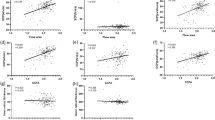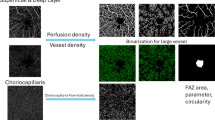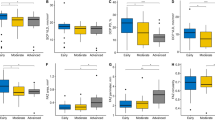Abstract
Purpose
To investigate the relationship between choriocapillaris perfusion and photoreceptor integrity in pachychoroid pigment epitheliopathy (PPE).
Methods
We compared 44 PPE eyes with 30 healthy controls using swept-source OCT angiography to analyse ellipsoid zone reflectivity, choriocapillaris flow deficit percentage (FD%) and retinal capillary perfusion.
Results
PPE eyes showed significantly reduced EZ reflectivity compared to controls (0.73 ± 0.10 vs 0.79 ± 0.05, p = 0.014), increased choriocapillaris ischemia (CC FD%: 46.6 ± 6.3 vs 32.5 ± 2.9, p < 0.001), and reduced deep capillary plexus perfusion (33.1 ± 4.6 vs 38.6 ± 3.3, p < 0.001). Multiple regression analysis revealed a significant inverse association between increased CC ischemia and reduced EZ reflectivity (r = −0.364, p < 0.001).
Conclusion
Choriocapillaris ischemia significantly correlates with photoreceptor damage in PPE, suggesting vascular dysfunction as a key pathogenic mechanism.
This is a preview of subscription content, access via your institution
Access options
Subscribe to this journal
Receive 18 print issues and online access
$259.00 per year
only $14.39 per issue
Buy this article
- Purchase on SpringerLink
- Instant access to full article PDF
Prices may be subject to local taxes which are calculated during checkout



Similar content being viewed by others
Data availability
The datasets generated and analysed during the current study are not publicly available due to privacy concerns and regulations regarding patient data protection, but de-identified data are available from the corresponding author upon reasonable request and with appropriate institutional review board approval.
References
Warrow DJ, Hoang QV, Freund KB. Pachychoroid pigment epitheliopathy. Retina. 2013;33:1659–72.
Yagi M, Miyake M, Mori Y, Hosoda Y, Takahashi A, Muraoka Y, et al. Natural course of pachychoroid pigment epitheliopathy. Ophthalmology Sci. 2022;2:100201.
Karacorlu M, Ersoz MG, Arf S, Hocaoglu M, Sayman Muslubas I. Long-term follow-up of pachychoroid pigment epitheliopathy and lesion characteristics. Graefes Arch Clin Exp Ophthalmol. 2018;256:2319–26.
Viggiano P, Miere A, Borrelli E, Boscia G, Grassi MO, Souied EH, et al. The impact of diabetic retinopathy on the choriocapillaris in neovascular AMD. Invest Ophthalmol Vis Sci. 2023;64:32.
Viggiano P, Boscia G, Borrelli E, Toto L, Grassi MO, Evangelista F, et al. Choriocapillaris reperfusion in resolved chronic central serous chorioretinopathy treated with eplerenone: long-term effects on the fellow eye. Ophthalmol Ther. 2023;12:3199–210.
Harada N, Nagai N, Mushiga Y, Ozawa Y. Choriocapillaris flow imbalance in fellow eyes in age-related macular degeneration. Invest Ophthalmol Vis Sci. 2022;63:13.
Quarta A, Gironi M, Ruggeri ML, Aharrh-Gnama A, Porreca A, D'Aloisio R, et al. Baseline imaging characteristics and early structural changes in macula on rhegmatogenous retinal detachment. Sci Rep. 2024;14:1370.
Borrelli E, Palmieri M, Viggiano P, Ferro G, Mastropasqua R. Photoreceptor damage in diabetic choroidopathy. Retina. 2020;40:1062–9.
Borrelli E, Abdelfattah NS, Uji A, Nittala MG, Boyer DS, Sadda SR. Postreceptor neuronal loss in intermediate age-related macular degeneration. Am J Ophthalmol. 2017;181:1–11.
Birol G, Wang S, Budzynski E, Wangsa-Wirawan ND, Linsenmeier RA. Oxygen distribution and consumption in the macaque retina. Am J Physiol Heart Circ Physiol. 2007;293:1696–704.
Yi J, Liu W, Chen S, Backman V, Sheibani N, Sorenson CM, et al. Visible light optical coherence tomography measures retinal oxygen metabolic response to systemic oxygenation. Light Sci Appl. 2015;4:334.
Ersoz MG, Karacorlu M, Arf S, Hocaoglu M, Sayman Muslubas I. Outer nuclear layer thinning in pachychoroid pigment epitheliopathy. Retina. 2018;38:957–61.
Ersoz MG, Karacorlu M, Arf S, Hocaoglu M, Sayman Muslubas I. Pachychoroid pigment epitheliopathy in fellow eyes of patients with unilateral central serous chorioretinopathy. British J Ophthalmol. 2018;102:473–8.
Baek J, Lee JH, Chung BJ, Lee K, Lee WK. Choroidal morphology under pachydrusen. Clin Exp Ophthalmol. 2019;47:498–504.
Sakurada Y, Fragiotta S, Leong BCS, Parikh R, Hussnain SA, Freund KB. Relationship between choroidal vascular hyperpermeability, choriocapillaris flow density, and choroidal thickness in eyes with pachychoroid pigment epitheliopathy. Retina. 2020;40:657–62.
Lee SY, Stetson PF, Ruiz-Garcia H, Heussen FM, Sadda SR. Automated characterization of pigment epithelial detachment by optical coherence tomography. Invest Ophthalmol Vis Sci. 2012;53:164–70.
Hu Z, Nittala MG, Sadda SVR. Comparison of retinal layer intensity profiles from different OCT devices. Ophthalmic Surg Lasers Imaging Retin. 2013;44:5–10.
Di Antonio, Viggiano P, Ferro G, Toto L, D'Aloisio R, Porreca A, et al. Retinal vascular metrics difference by comparison of two image acquisition modes using a novel OCT angiography prototype. PLoS One. 2020;15:0243074.
Viggiano P, Costanzo E, Giannini D, Fragiotta S, De Geronimo D, Giorno P, et al. In vivo assessment of associations between photoreceptors structure and macular perfusion in type 1 diabetes. Br J Ophthalmol. 2022;107:1672–9.
Boscia G, Bacherini D, Vujosevic S, Grassi MO, Borrelli E, Giancipoli E, et al. Long-term impact of diabetic retinopathy on response to anti-VEGF treatment in neovascular AMD. Invest Ophthalmol Vis Sci. 2024;65:6.
Mastropasqua R, Evangelista F, Amodei F, D'Aloisio R, Pinto F, Doronzo E, et al. Optical coherence tomography angiography in macular neovascularization: a comparison between different octa devices. Transl Vis Sci Technol. 2020;9:1–7.
Chu Z, Zhang Q, Gregori G, Rosenfeld PJ, Wang RK. Guidelines for imaging the choriocapillaris using OCT angiography. Am J Ophthalmol. 2021;222:92–101.
Fujita A, Aoyama Y, Tsuneyoshi S, Sugiura A, Azuma K, Asano-Shimizu K, et al. Association between visual function and the integrity of residual ellipsoid zone in resolved central serous chorioretinopathy. Sci Rep. 2019;9:12433.
Sugiura A, Fujino R, Takemiya N, Shimizu K, Matsuura M, Murata H, et al. The association between visual function and retinal structure in chronic central serous chorioretinopathy. Sci Rep. 2017;7:16288.
Lee JH, Kim JY, Jung BJ, Lee WK. Focal disruptions in ellipsoid zone and interdigitation zone on spectral-domain optical coherence tomography in pachychoroid pigment epitheliopathy. Retina. 2019;39:1562–70.
Scarinci F, Nesper PL, Fawzi AA. Deep retinal capillary nonperfusion is associated with photoreceptor disruption in diabetic macular ischemia. Am J Ophthalmol. 2016;168:129–38.
Viggiano P, Boscia G, Sadeghi E, Cheung G, Borrelli E, Alessio G, et al. Pachychoroid disease spectrum: how multimodal imaging and OCT angiography have improved our knowledge. Prog Retin Eye Res. 2025;107:101372.
Viggiano P, Moscara F, Termite AC, Boscia G, La Terza M, Salvelli A, et al. Choroidal layer analysis under flat irregular pigment epithelial detachments in central serous chorioretinopathy. Am J Ophthalmol. 2025;276:210–7.
Baek J, Kook L, Lee WK. Choriocapillaris flow impairments in association with pachyvessel in early stages of pachychoroid. Sci Rep. 2019;9:1–6.
Cheung CMG, Dansingani KK, Koizumi H, Lai TYY, Sivaprasad S, Boon CJF, et al. Pachychoroid disease: review and update. Eye. 2024;39:819–34.
Hua R, Duan J, Zhang M. Pachychoroid spectrum disease: underlying pathology, classification, and phenotypes. Curr Eye Res. 2021;46:1437–48.
Tagawa M, Ooto S, Yamashiro K, Tamura H, Oishi A, Uji A, et al. Choriocapillaris flow deficit in a pachychoroid spectrum disease using en face optical coherence tomography angiography averaging. PLoS One. 2022;17:e0271747.
Mahalingam M, Sachidanandam R, Verma A, Alagorie AR, Sen P. Choriocapillaris flow deficits in polypoidal choroidal vasculopathy using swept source optical coherence tomography angiography. Indian J Ophthalmol. 2022;70:3002–7.
Funding
PV is a consultant for: Abbvie, Bayer, Hofmann La Roche, Novartis and Zeiss. FB is a consultant for: Alcon, Abbvie, Bayer, Hofmann La Roche, Novartis and Zeiss. Other authors: None.
Author information
Authors and Affiliations
Contributions
PV conceived the study, performed data analysis and drafted the manuscript. GB and AC contributed to study design and critically revised the manuscript. ML and ACT were involved in data collection and interpretation. MGP and AC provided expertise in image analysis and contributed to the interpretation of results. SD and GA contributed to patient recruitment and data collection. FB and GA provided statistical expertise and critical feedback. FB supervised the study, provided critical feedback and helped shape the research and analysis. All authors reviewed and approved the final version of the manuscript.
Corresponding author
Ethics declarations
Competing interests
The authors declare no competing interests.
Additional information
Publisher’s note Springer Nature remains neutral with regard to jurisdictional claims in published maps and institutional affiliations.
Supplementary information
Rights and permissions
Springer Nature or its licensor (e.g. a society or other partner) holds exclusive rights to this article under a publishing agreement with the author(s) or other rightsholder(s); author self-archiving of the accepted manuscript version of this article is solely governed by the terms of such publishing agreement and applicable law.
About this article
Cite this article
Viggiano, P., Termite, A.C., Boscia, G. et al. Photoreceptor damage in pachychoroid pigment epitheliopathy. Eye 39, 2774–2779 (2025). https://doi.org/10.1038/s41433-025-03947-3
Received:
Revised:
Accepted:
Published:
Issue date:
DOI: https://doi.org/10.1038/s41433-025-03947-3
This article is cited by
-
Ellipsoid zone reflectivity changes after idiopathic epiretinal membrane peeling: a pilot study
International Ophthalmology (2025)
-
Distinct Pathogenic Mechanisms of Neurodegeneration in Pachychoroid Pigment Epitheliopathy Versus Intermediate Age-Related Macular Degeneration
Ophthalmology and Therapy (2025)



